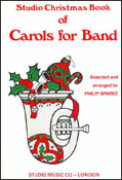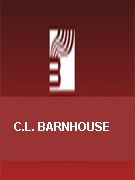Results
-
 £4.95
£4.95Carols for Band (1st Flute & Piccolo) - Sparke, Philip
Designed to be playable by any combination from quartet to full brass band, wind band or orchestra, the arrangements in this book with provide a practical solution to all your carolling needs. Parts are divided into Soprano, Alto, Tenor and Bass so that any suitable instrumentation will sound well, providing an equal balance of players per voice is maintained. The carols are printed in alphabetical order so they are easy to find, and comprehensively indexed under both first line and name of tune.Instrumentation is as follows: Brass BandWind BandStringsSopranoEb Soprano CornetSolo Bb CornetBb Repiano & Flugel1st Flute & Piccolo2nd FluteOboe1st Bb Clarinet1st Bb Trumpet/Cornet1st ViolinAlto2nd & 3rd Bb CornetSolo Eb Horn1st Bb Trombone2nd & 3rd Bb ClarinetsEb Alto Saxophone2nd Bb Trumpet/Cornet1st F Horn2nd ViolinTenor1st & 2nd Eb Horns1st & 2nd Bb Baritones2nd Bb Trombone1st Bb EuphoniumEb Alto ClarinetBb Tenor Saxophone2nd F Horn1st & 2nd TrombonesViolaBassBass Trombone2nd Bb EuphoniumEb BassBb BassBassoonBb Bass ClarinetEb Baritone SaxophoneBass TromboneEuphoniumTubaCello/BassTitles included:Angels from the Realms of GloryAs with Gladness Men of OldAway in a MangerBrightest and BestChristians AwakeCoventry CarolDeck the HallsDing Dong, Merrily on HighFirst NowellGod Rest ye Merry, GentlemenGood King WenceslasHark the Glad SoundHark, the Herald Angels SingHolly and the IvyI Saw Three ShipsIn Dulci JubiloIn the Bleak Mid-WinterInfant HolyInfant KingIt Came Upon a Midnight ClearJingle BellsLo, He Comes with Clouds DescendingLove Came Down at ChristmasO Come, All ye FaithfulO Come, O Come, EmmanuelO Little Town of BethlehemOf the Father's Love BegottenOnce in Royal David's CitySans Day CarolSee Amid the Winter's SnowSilent NightSussex CarolThou Didst Leave Thy ThroneUnto Us is Born a SonWe Wish You a Merry ChristmasWhile Shepherds Watched
Estimated dispatch 7-14 working days
-
 £19.95
£19.95Carols for Band (Piano Conductor Score) - Sparke, Philip
Designed to be playable by any combination from quartet to full brass band, wind band or orchestra, the arrangements in this book with provide a practical solution to all your carolling needs. Parts are divided into Soprano, Alto, Tenor and Bass so that any suitable instrumentation will sound well, providing an equal balance of players per voice is maintained. The carols are printed in alphabetical order so they are easy to find, and comprehensively indexed under both first line and name of tune.Score, Timpani and Percussion parts are available separately.Instrumentation is as follows: Brass BandWind BandStringsSopranoEb Soprano CornetSolo Bb CornetBb Repiano & Flugel1st Flute & Piccolo2nd FluteOboe1st Bb Clarinet1st Bb Trumpet/Cornet1st ViolinAlto2nd & 3rd Bb CornetSolo Eb Horn1st Bb Trombone2nd & 3rd Bb ClarinetsEb Alto Saxophone2nd Bb Trumpet/Cornet1st F Horn2nd ViolinTenor1st & 2nd Eb Horns1st & 2nd Bb Baritones2nd Bb Trombone1st Bb EuphoniumEb Alto ClarinetBb Tenor Saxophone2nd F Horn1st & 2nd TrombonesViolaBassBass Trombone2nd Bb EuphoniumEb BassBb BassBassoonBb Bass ClarinetEb Baritone SaxophoneBass TromboneEuphoniumTubaCello/BassTitles included:Angels from the Realms of GloryAs with Gladness Men of OldAway in a MangerBrightest and BestChristians AwakeCoventry CarolDeck the HallsDing Dong, Merrily on HighFirst NowellGod Rest ye Merry, GentlemenGood King WenceslasHark the Glad SoundHark, the Herald Angels SingHolly and the IvyI Saw Three ShipsIn Dulci JubiloIn the Bleak Mid-WinterInfant HolyInfant KingIt Came Upon a Midnight ClearJingle BellsLo, He Comes with Clouds DescendingLove Came Down at ChristmasO Come, All ye FaithfulO Come, O Come, EmmanuelO Little Town of BethlehemOf the Father's Love BegottenOnce in Royal David's CitySans Day CarolSee Amid the Winter's SnowSilent NightSussex CarolThou Didst Leave Thy ThroneUnto Us is Born a SonWe Wish You a Merry ChristmasWhile Shepherds Watched
Estimated dispatch 7-14 working days
-
 £179.99
£179.99Austrian Overture (Concert Band - Score and Parts)
Austria is an industrious country. During the last century--which was characterized by extreme changes--the hard-working and ambitious people achieved a great deal, enduring two world wars and numerous political skirmishes. Despite all the problems involved in a change from a dual monarchy to a small state, Austria has found its independence. With his Austrian Overture, Thomas Doss looks toward the future. The first part of the composition provides an optimistic outlook; along with the happiness and energy, some musical humor is also present: while the horns powerfully express joy, small yodeling melodies sound throughout. As the rhythm continues in search of new ways to go, catchy tunes compete to be heard. However, in addition to the energetic, diligent Austria, there's also the quiet landscape where one can enjoy repose and beauty. These aspects - as well as the freedom of spirit and cultural life -are conveyed in the second part of the work through the surprising linking of chords, romantic phrasing, and tender melodies. But life never stands still: creativity, ambition, and work are the driving forces of our existence. Embracing this thought, a reprise of the first part provides a compelling ending. 10:26
Estimated dispatch 7-14 working days
-
 £49.50
£49.50Bennington (Concert Band - Score and Parts)
Simply one of the best pieces you can find to teach the youngest of players the combination of a good New Orleans sound mixed with a nice little dose of jazz. Gerald Sebesky gets the best out of your band with this very useful piece.
Estimated dispatch 7-14 working days
-
 £149.99
£149.99Bridge Between Nations Wind Band Set (Score & Parts)
This work builds a musical bridge between the nations of the European Union. In this composition each country is represented by a fragment of its national anthem. The listener will continually be surprised by the creative way the national anthems are presented. The national anthems of the nations that have become part of the EU in 2004 have already been included in this piece. Because the fragments follow each other and complement each other in a logical way, this work does not sound like a regular medley but rather like a varied concert work with interesting elements of folklore. For most of the national anthems Jacob de Haan has chosen a minor key, which gives this work an extra emotional, sometimes melancholic overtone. 0:09:30
Estimated dispatch 7-14 working days
-
 £43.56
£43.56Calypso Bells (Concert Band - Score and Parts)
In this fresh twist on the old classic "Jingle Bells," your beginning band students are sure to have fun as the Latin rhythms and percussion instruments combine with the traditional melody. Todd Phillips seamlessly weaves familiar Latin themes with "Jingle Bells" to create a unique holiday arrangement. This arrangement will work well with students who have had two semesters of band. This setting provides an excellent opportunity for students to learn to play Latin rhythms while the percussion section learns to play the traditional Latin percussion instruments. A welcome change of pace for your next winter concert; "Calypso Bells" is the perfect opportunity to combine the warmth of the Latin sound with the coolness of "Jingle Bells."
Estimated dispatch 7-14 working days
-
 £4.95
£4.95Carols for Band (1st F Horn) - Sparke, Philip
Designed to be playable by any combination from quartet to full brass band, wind band or orchestra, the arrangements in this book with provide a practical solution to all your carolling needs. Parts are divided into Soprano, Alto, Tenor and Bass so that any suitable instrumentation will sound well, providing an equal balance of players per voice is maintained. The carols are printed in alphabetical order so they are easy to find, and comprehensively indexed under both first line and name of tune.Instrumentation is as follows: Brass BandWind BandStringsSopranoEb Soprano CornetSolo Bb CornetBb Repiano & Flugel1st Flute & Piccolo2nd FluteOboe1st Bb Clarinet1st Bb Trumpet/Cornet1st ViolinAlto2nd & 3rd Bb CornetSolo Eb Horn1st Bb Trombone2nd & 3rd Bb ClarinetsEb Alto Saxophone2nd Bb Trumpet/Cornet1st F Horn2nd ViolinTenor1st & 2nd Eb Horns1st & 2nd Bb Baritones2nd Bb Trombone1st Bb EuphoniumEb Alto ClarinetBb Tenor Saxophone2nd F Horn1st & 2nd TrombonesViolaBassBass Trombone2nd Bb EuphoniumEb BassBb BassBassoonBb Bass ClarinetEb Baritone SaxophoneBass TromboneEuphoniumTubaCello/BassTitles included:Angels from the Realms of GloryAs with Gladness Men of OldAway in a MangerBrightest and BestChristians AwakeCoventry CarolDeck the HallsDing Dong, Merrily on HighFirst NowellGod Rest ye Merry, GentlemenGood King WenceslasHark the Glad SoundHark, the Herald Angels SingHolly and the IvyI Saw Three ShipsIn Dulci JubiloIn the Bleak Mid-WinterInfant HolyInfant KingIt Came Upon a Midnight ClearJingle BellsLo, He Comes with Clouds DescendingLove Came Down at ChristmasO Come, All ye FaithfulO Come, O Come, EmmanuelO Little Town of BethlehemOf the Father's Love BegottenOnce in Royal David's CitySans Day CarolSee Amid the Winter's SnowSilent NightSussex CarolThou Didst Leave Thy ThroneUnto Us is Born a SonWe Wish You a Merry ChristmasWhile Shepherds Watched
Estimated dispatch 7-14 working days
-
 £104.99
£104.99German Folk Fantasy (Concert Band - Score and Parts)
Take a musical tour of the North of Germany with sailors' music from the coastal areas combining with the authentic traditional folk music culture of the region. This colourful blend of many different styles of the North German music folklore are given a unique twist being wrapped in a grand big band sound, ensuring these fine melodies appeal not only to North German people but to a worldwide audience. 04:55
Estimated dispatch 7-14 working days
-
 £49.50
£49.50Kaboom!
"Kaboom!" is an aggressive work for young band that is sure to capture the incredible energy and passion of young musicians. It begins with an explosion of sound and power. The tension then subsides before building to a thunderous climax of driving rhythms and contemporary, fresh sounding harmonies. Memorable melodic themes, stark musical contrasts and the dark, foreboding middle section will make this work a favorite for concert and festival use. This is the type of piece your students will love to rehearse, and it's sure to be the hit of any concert!
Estimated dispatch 7-14 working days
-
 £134.99
£134.99L'Italiana in Algeri Wind Band Set (Score & Parts)
Gioacchino Rossini was a musical prodigy, composing his first operawhen he was eighteen years old. At the age of 37, after having written39 operas in all, he almost completely stopped composing anddevoted himself to the culinary art and the mysteries of wine! In hisopera L'Italiana in Algeri, Rossini shows the difference in mentalitybetween two countries on both sides of the Mediterranean, Turkeyand Italy. The exotic themes and oriental sound colours of thisopera have ensured that it is still loved today by a wide audience.This transcription for concert band retains the exotic and orientalfeel of the original opera. 0:08:30
Estimated dispatch 7-14 working days
